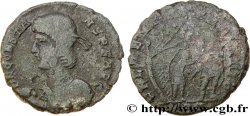E-auction 370-282627 - brm_556309 - LICINIUS I Follis ou nummus
You must signin and be an approved bidder to bid, LOGIN TO BID. Accounts are subject to approval and the approval process takes place within 48 hours. Do not wait until the day a sale closes to register. Clicking on « bid » constitutes acceptance of the terms of use of cgb.fr private e-auctions.
Bids must be placed in whole Euro amounts only. The sale will start closing at the time stated on the item description; any bids received at the site after the closing time will not be executed. Transmission times may vary and bids could be rejected if you wait until the last second. For further information ckeck the E-auctions F.A.Q.
NO BUYER'S FEE.
NO BUYER'S FEE.
| Estimate : | 95 € |
| Price : | 56 € |
| Maximum bid : | 56 € |
| End of the sale : | 18 May 2020 14:12:00 |
| bidders : | 11 bidders |
Type : Follis ou nummus
Date: 313
Mint name / Town : Héraclée
Metal : copper
Diameter : 22 mm
Orientation dies : 12 h.
Weight : 3,04 g.
Officine: 1re
Coments on the condition:
Exemplaire de qualité exceptionnelle pour ce type de monnayage. Belle tête de Licinius Ier. Revers de haut relief. Magnifique patine vert foncé. Conserve l’intégralité de son brillant de frappe et de son coupant d’origine
Catalogue references :
Obverse
Obverse legend : IMP C VAL LICIN LICINIVS P F AVG.
Obverse description : Tête laurée de Licinius Ier à droite (O*).
Obverse translation : "Imperator Cæsar Valerius Licinianus Licinius Pius Felix Augustus", (L'empereur césar Valerius Licinianus Licinius pieux heureux auguste).
Reverse
Reverse legend : IOVI CONSER-VATORI AVGG/ -|A// SMHT.
Reverse description : Jupiter nicéphore nu, debout à gauche, le manteau sur l'épaule, tenant un globe nicéphore de la main droite et un sceptre long de la gauche ; un aigle dans le champ à gauche, tournant la tête à droite.
Reverse translation : “Iovi Conservatori Augustorum”, (À Jupiter protecteur des augustes).
Commentary
Poids extrêmement léger. Rubans de type 3. Le diamètre de ce follis fait plutôt penser aux émissions antérieures à 313, mais le poids très léger ne plaide pas en faveur de cette hypothèse.








 Report a mistake
Report a mistake Print the page
Print the page Share my selection
Share my selection Ask a question
Ask a question Consign / sell
Consign / sell
 Full data
Full data















